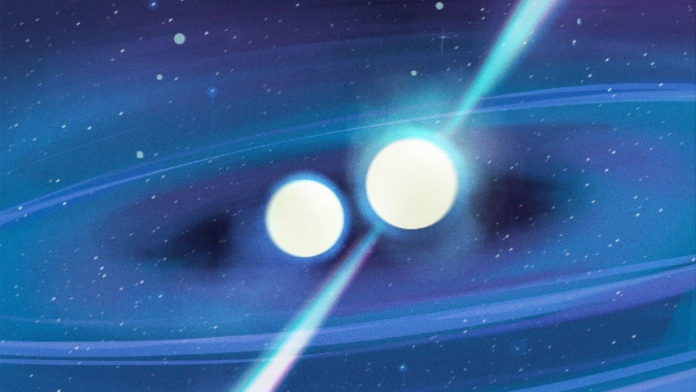An international team, led by the University of East Anglia, has made a breakthrough that can pave the way towards a detailed understanding of dead star collisions and the expansion of the Universe.
Scientists have discovered an unusual pulsar known as PSR J1913+1102- pulsar that is part of a binary system. Means, it is locked in a fiercely tight orbit with another neutron star.
Scientists called the pulsar unusual because of different masses of its two neutron stars- one far larger than the other.
This asymmetric system enabled scientists to think that binary neutron star mergers will provide vital clues about mysteries in astrophysics—including a more accurate determination of the expansion rate of the Universe, known as the Hubble constant.
Scientists made this discovery using the Arecibo radio telescope in Puerto Rico.
Lead researcher Dr. Robert Ferdman, from UEA‘s School of Physics, said: “Back in 2017, scientists at the Laser Interferometer Gravitational-Wave Observatory (LIGO) first detected the merger of two neutron stars.”
“The event caused gravitational-wave ripples through the fabric of space-time, as predicted by Albert Einstein over a century ago.”
Known as GW170817, this spectacular event was also seen with traditional telescopes at observatories around the world, which identified its location in a distant galaxy, 130 million light-years from our own Milky Way.
So the GW170817 event was not surprising. But the enormous amount of matter ejected from the merger, and its brightness was an unexpected mystery.
Dr. Ferdman said: “It confirmed that the phenomenon of short gamma-ray bursts was due to the merger of two neutron stars. And these are now thought to be the factories that produce most of the heaviest elements in the Universe, such as gold.”
Dr. Ferdman said: “Most theories about this event assumed that neutron stars locked in binary systems are very similar in mass.
“Our discovery changes these assumptions. We have uncovered a binary system containing two neutron stars with very different masses.”
“These stars will collide and merge in around 470 million years, which seems like a long time, but it is only a small fraction of the age of the Universe.”
“Because one neutron star is significantly larger, its gravitational influence will distort the shape of its companion star—stripping away large amounts of matter just before they merge, and potentially disrupting it altogether.”
“This ‘tidal disruption’ ejects a more significant amount of hot material than expected for equal-mass binary systems, resulting in a more powerful emission.”
“Although other theories can explain GW170817, we can confirm that a parent system of neutron stars with significantly different masses, similar to the PSR J1913+1102 system, is a very plausible explanation.”
“Perhaps, more importantly, the discovery highlights that there are many more of these systems out there—making up more than one in 10 merging double neutron star binaries.”
Co-author Dr. Paulo Freire from the Max Planck Institute for Radio Astronomy in Bonn, Germany, said: “Such a disruption would allow astrophysicists to gain critical new clues about the exotic matter that makes up the interiors of these extreme, dense objects.
“This matter is still a major mystery—it’s so dense that scientists still don’t know what it is made of. These densities are far beyond what we can reproduce in Earth-based laboratories.”
The disruption of the lighter neutron star would also enhance the brightness of the material ejected by the merger. This means that along with gravitational-wave detectors such as the US-based LIGO and the Europe-based Virgo detector, scientists will also be able to observe them with conventional telescopes.
Dr. Ferdman said: “Excitingly, this may also allow for a completely independent measurement of the Hubble constant—the rate at which the Universe is expanding. The two main methods for doing this are currently at odds with each other, so this is a crucial way to break the deadlock and understand in more detail how the Universe evolved.”
Journal Reference:
- Asymmetric mass ratios for bright double neutron-star mergers, Nature (2020). DOI: 10.1038/s41586-020-2439-x
